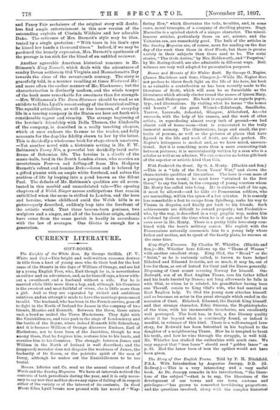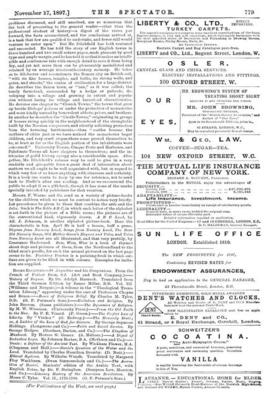The Story of Our English Towns. Told by P. H.
Ditchfield, F.S.A. With Introduction by Augustus Jessopp, D.D. (G. Redway.) — This is a very interesting and a very useful book. As Dr. Jessopp remarks in his introduction, "the litera- ture of the subject "—that is to say, the literature of the development of our towns and our town customs and privileges—" has grown to somewhat bewildering proportions, and the questions involved, along with the complex historical problems discussed, and still unsolved, are so numerous that the task of presenting to the general reader—other than the professional student of history—a digest of the views put forward, the facts accumulated, and the conclusions arrived at, is a task that few are qualified to undertake, and fewer still would venture to enter upon." But Mr. Ditchfleld has both ventured and succeeded. He has told the story of our English towns in three hundred and two small octavo pages, made pleasant by good type and ample margin, and he has told it so that it makes an intelli- gible and continuous tale with enough detail to save it from being dry, and yet not more than can be pleasurably assimilated and retained by an average nineteenth-century memory. He takes as to Sfichester and reconstructs the Roman city on British soil. " with its fine houses, temples, and baths, its strong walls, and gates, and streets," the centre of civilisation for a large district. He describes the Saxon town, or "tun," as it was called; the lonely farmstead, surrounded by a hedge or palisade, de- veloping into a village and growing in extent and popula- tion without losing its village and farmstead characteristics. He devotes one chapter to "Church Towns," the towns that grow ap beside Bishops' palaces or under the protection of monasteries and were kindly nursed by benevolent abbots, priors, and brothers. In another he describes the "Castle Towns," originating in groups of houses rising quickly in the neighbourhood of the strongholds built by the Norman conquerors, and silently soliciting protection from the towering battlements,—thus "castles became the mothers of cities just as we have noticed the monasteries begat children, and very cruel stepmothers some proved themselves to be, at least as far as the English portion of the inhabitants were concerned." University Towns, Cinque Ports and Harbours. and Palatinate Towns all have chapters to themselves; and the in- tricacies of guild history occupy also a considerable space. Alto- gether, Mr. Ditchfield's volume may be said to give in a very readable and graspable form a great deal of information about matters we all ought to be well acquainted with, but in regard to which very few of us know anything with clearness and certainty. It is a book one wants to keep by one for reference, not to send back to bindle's after one reading. And so we recommend tho public to adopt it as a gift-book, though it has none of the marks specially intended by publishers for that vocation.
Messrs. F. Warne and Co. send us a variety of picture-books for the children which we must be content to notice very briefly. Let precedence be given to those that combine the utile and the duke. Such is The Bible A B 0, in which each letter of the alphabet is set forth in the picture of a Bible scene ; the pictures are of the conventional kind, vigorously drawn. A B C Land, by Alf. J. Johnson, is another alphabet picture-book. Here the characteristic is fun. Spell Me is half a lesson, half a game. Rhymes from Nursery Land, Songs from Nursery Land, The Dear Old Nursery Songs, Old Mother Goose's Rhymes and Tales, and Tales from Nursery Land are all illustrated, and that very prettily, by Constance Haslewood. Bow, Wow, Wow is a book of rhymes about dogs and pictures of them, from the Newfoundland to the blind man's poodle, for such the animal pictured on the last page seems to be. Finishing Touches is a painting-book in which out- lines are given to be filled in with colours. Examples for imita- tion are supplied.







































 Previous page
Previous page